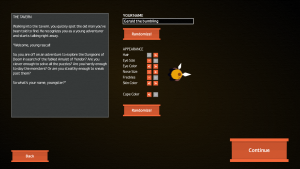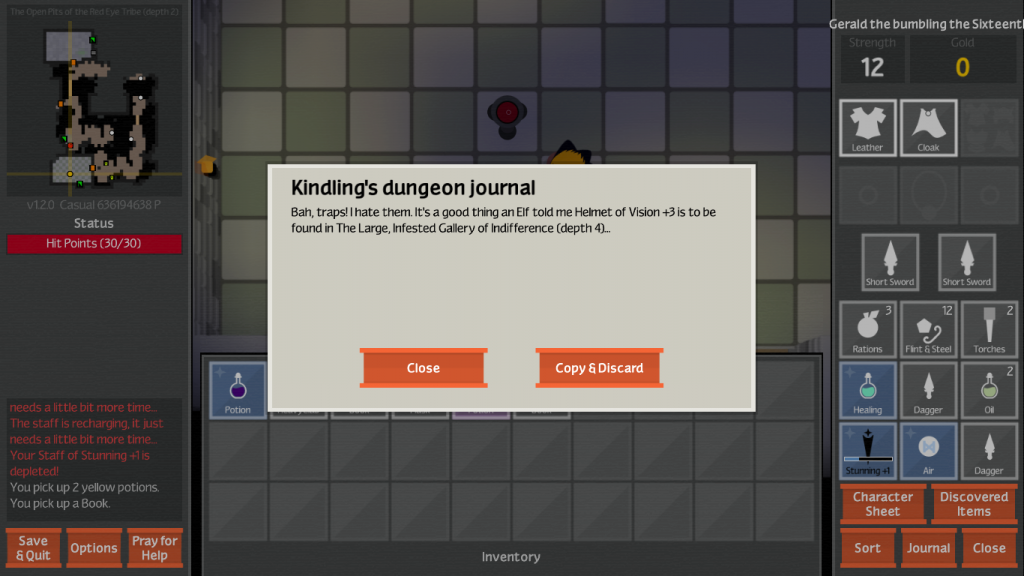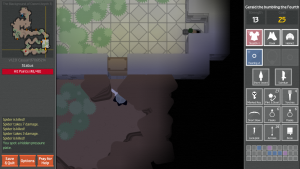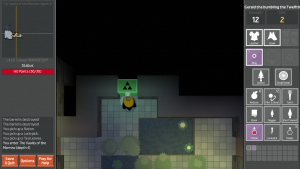Unexplored: Going Round In Circles
Unexplored is a top down dungeon crawler with a twist.
While most dungeon crawlers and other rogue-likes function with a split tree format, with branches breaking off to different areas. Unexplored works with a cyclic pathway, going back to the same areas then going back out again. The best example of this that I can think of is the dungeons from Skyrim, where the end of a dungeon is linked to the entrance. I don’t really know how to explain it better, but the trailer, found here, explains it very well.

Playing as an explorer, far travelled to venture into this evil dungeon, your goal is to successfully make your way down the levels of the dungeon, acquire as much loot as possible and make your way out again. When starting a game, you can spend a bit of your gold on getting some local knowledge about the dungeon, or buy a bit of gear from the local stores before making your way down.
There are two main mechanics to Unexplored, combat and puzzling. Combat is done in a very interesting fashion with weapons able to be assigned to the two hands of your hero, controlled by the left and right buttons on your mouse. There are a variety of weapons available to be used, varying from magical staffs to daggers, sword and clubs. You can ‘use’ weapons by clicking the mouse to do an attack with them, such as throwing a knife or swinging a blade but enemies can also walk onto the blade if positioned right. Weapons have a cool down after being used, which doesn’t make much sense if a bat rams itself onto your broadsword, which then cannot be used again for several seconds.
The puzzles are one of the shining pieces of Unexplored. Most levels will have levers scattered through them to open doors, which help move the player through the level. A simple puzzle might be figuring how to hold a door open to escape a room, and a complex puzzle might ask you to work out which rune symbolises a key, to unlock a secret room with delicious loot. When starting a game, ‘More puzzles’ is an option given to the player, to allow players to work out what works best for them. If you fail a puzzle or are otherwise trapped, you are able to ‘pray to the gods’ who will either give you a way out or just teleport you outside the locked room. This function means that most runs end with you dying instead of getting trapped due to a bug or glitch.

Books are found throughout the levels of the dungeon, and can offer valuable information to the player. A book might warn of traps ahead, it might tell of a pyrotechnic sorcerer on the next floor, and inform the player where a ‘resist fire’ potion can be found, or it could mention a powerful bow to be found on a deeper floor. These books, whilst giving the player valuable intel, also build up the mythos of the world, giving the names of previous explorers who have ventured down into the depths and making the world feel fluidic, rather than stale and stationary.
There are a wide variety of enemies infesting the dungeon, starting of with simple creatures such as lizards and bats. Further down harder enemies appear, such as goblins with weapons similar to yours. Large trolls function as bosses to floors, and various magical beasts offer an increase in difficulty further down. My personal favorite/hated enemy is the dark bat, which when hit can teleport away, making swarms extremely hard to deal with.
 As you progress through the dungeon, loot and other various items can be collected, either off dead enemies, the floor or chest in various rooms. This loot varies from weapons and tools, food and potions to magic spells. Armour and other items are also present in the dungeon, and can provide a decisive tactical advantage. A ring which gives you a buff to hearing might allow you to detect enemies earlier, and an amulet of sneakiness will allow you to sneak around easier. You start off the game with a set of leather armour and a basic cloak. The cloak allows you to become invisible when close to a wall in the dark, and allows you to perform sneak attacks for a huge amount of damage on enemies.
As you progress through the dungeon, loot and other various items can be collected, either off dead enemies, the floor or chest in various rooms. This loot varies from weapons and tools, food and potions to magic spells. Armour and other items are also present in the dungeon, and can provide a decisive tactical advantage. A ring which gives you a buff to hearing might allow you to detect enemies earlier, and an amulet of sneakiness will allow you to sneak around easier. You start off the game with a set of leather armour and a basic cloak. The cloak allows you to become invisible when close to a wall in the dark, and allows you to perform sneak attacks for a huge amount of damage on enemies.
The magic spells I mentioned earlier play a large part in both combat and when out of combat. Spell parchments can be combined with a weapon to make a magical weapon, which can be quite helpful to your run, such as a staff of stunning, which stuns any enemies in a range of a projectile. One particular spell parchment, called “descend” moves the player a floor down, often cutting out travel time and speeding up the game a little.

While most of the time it works well, it was the cause of my biggest bug whilst playing Unexplored. Whilst exploring a room on level 2, I found one such copy of this parchment, as I am wont to do, I immediately used it, without realising I was at the very top left on the map. The floor below, a caves level, did not take up the full size of the level and as such I was trapped outside the map. Praying to the gods did not work as the help circle appears on the closest block to you, in my case on the other side of an impenetrable wall. While this was a single case, it was a cause of much annoyance to me, cutting short my best run yet.
Unexplored has a large amount of replayability, what with it using randomly generated levels. When starting a new game, you can use the previous map if you need to just get past that troll to get to the loot room, or otherwise just want to succeed where you failed. 3 Levels of difficultly are available, changing the amount of gold, enemies and magical items on the run. As mentioned before, an option for more puzzles exist as well as an option to increase the amount of bosses, which will also increase the amount of gold in the run.
With just a few bugs and otherwise solid gameplay, Unexplored is a great dungeon crawler with graphics that make me nostalgic for the web games of the early 2000’s.
Comments are closed.